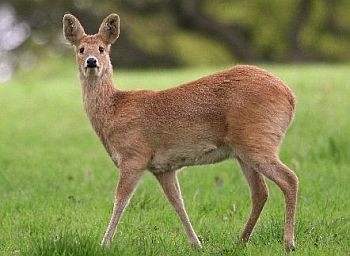Taxonomy: Class: Mammalia; Order: Artiodactyla; Family: Cervidae
Description

Chinese water deer, courtesy of British Deer Society image library
The Chinese water deer originates from China and Korea, and is associated with lush riparian or swampy habitats. Smaller than roe deer, the males have elongated upper canines and no antlers. Chinese water deer were introduced to Woburn Park, Bedfordshire, in 1896 and Whipsnade Park in 1929-1930. Deliberate releases and escapes have resulted in the species becoming established in the wild since 1945, originally around Woburn then gradually expanding its range. The Chinese water deer (both sexes) may be shot from 1 November to 31 March.
Further information:
Mammal Society website Chinese water deer page.
Conservation status and legislation
Status:
UK: Non-native
World: Vulnerable (IUCN Red List)
Legislation:
Distribution and abundance
The Chinese water deer has established itself mainly across south-eastern Britain. Its strongholds are in west Bedfordshire, the Cambridgeshire fens and the Norfolk Broads, but the distribution is discontinuous. Isolated records further afield probably reflect further introduction attempts.
Estimates of Chinese water deer abundance (numbers of individuals in the spring) across the UK, from Battersby (2005):
Recent trends from the National Gamebag Census
The Chinese water deer was first recorded in the NGC in 1993. Since then, it has been reported from 15 sites, in Norfolk (6), Bedfordshire (3), Suffolk (2), Cambridgeshire (1), Buckinghamshire (1), Oxfordshire (1) and Hampshire (1). There are too few bag records of Chinese water deer to produce trend estimates.
Environmental zones
Of the 15 NGC sites that reported Chinese water deer, 14 were in the Easterly Lowlands and one in the Westerly Lowlands of England. There are too few bag records of Chinese water deer to produce trend estimates.
Comparison with BBS mammal data
No comparison is possible because there are too few records.
Long-term trend from the National Gamebag Census
The Chinese water deer has been recorded in the NGC too late and too sparsely to evaluate long-term trend.
References and further reading
- Battersby,J. (2005). UK Mammals: Species Status and Population Trends. Joint Nature Conservation Committee/Tracking Mammals Partnership, Peterborough (JNCC download page).
- Cooke,A. & Farrell,L. (1998). The Chinese Water Deer. Mammal Society & British Deer Society, Southampton & Fordingbridge.
- Deer Initiative (2008). Species Ecology: Chinese Water Deer. England & Wales Best Practice Guides, The Deer Initiative, Chirk (PDF file - 3,720 KB).
- Fletcher,J. (2010). Deer parks and deer farming in Great Britain - history and current status. In Enclosures: a Dead-End? (eds N.G.Chapman & K.Hecker), pp. 54-61. International Council for Game and Wildlife Conservation, Budakeszi.
- Harris,S. & Yalden,D.W. (2008). Mammals of the British Isles: Handbook, 4th edition. Mammal Society, Southampton.
- Ward,A.I. (2005a). New population estimates for British mammals. Deer 13: 8.
- Ward,A.I. (2005b). Expanding ranges of wild and feral deer in Great Britain. Mammal Review 35: 165-173.
This report should be cited as: Aebischer,N.J., Davey,P.D. & Kingdon,N.G. (2011). National Gamebag Census: Mammal Trends to 2009. Game & Wildlife Conservation Trust, Fordingbridge (http://www.gwct.org.uk/ngcmammals).
Return to species list